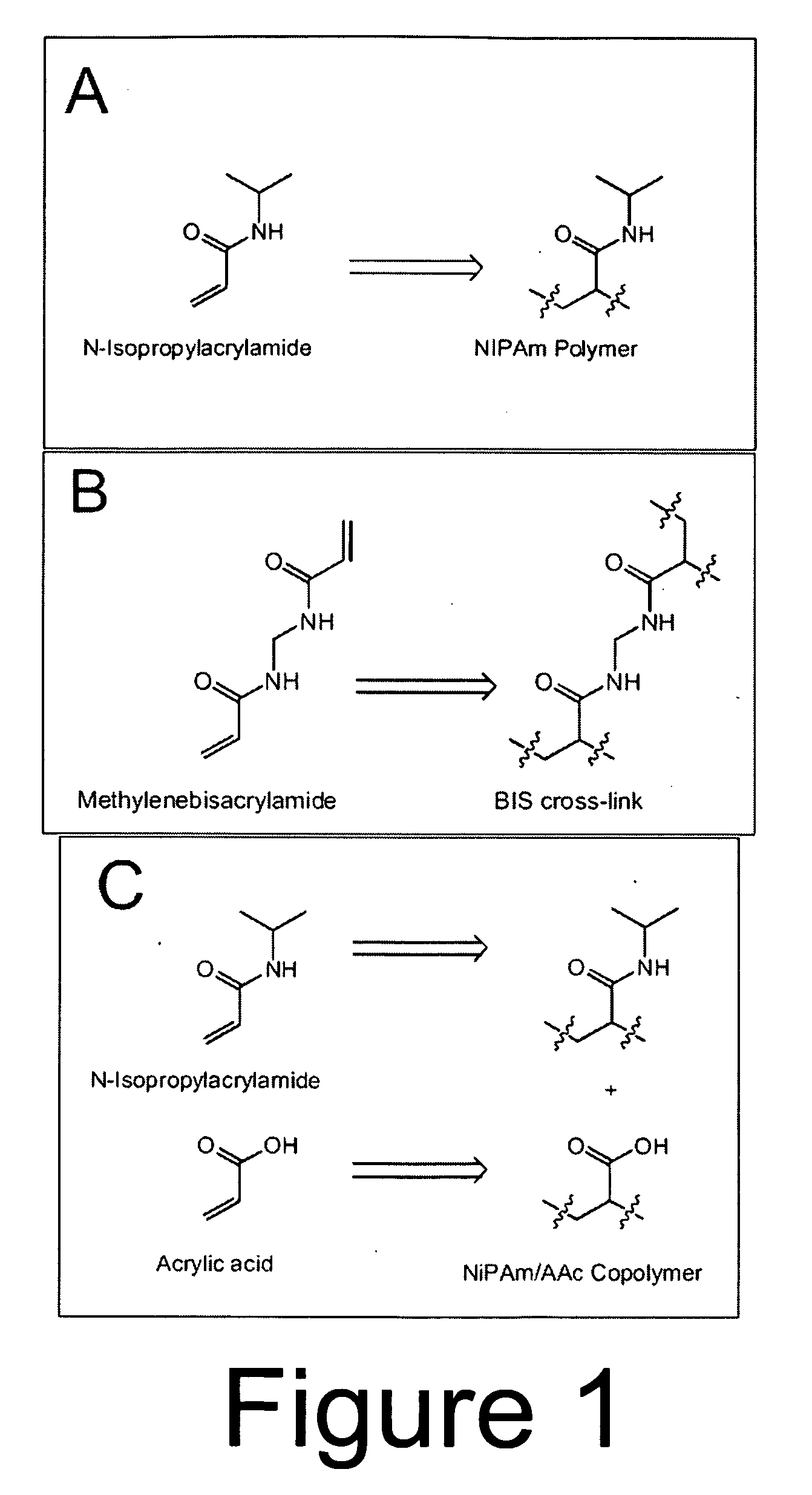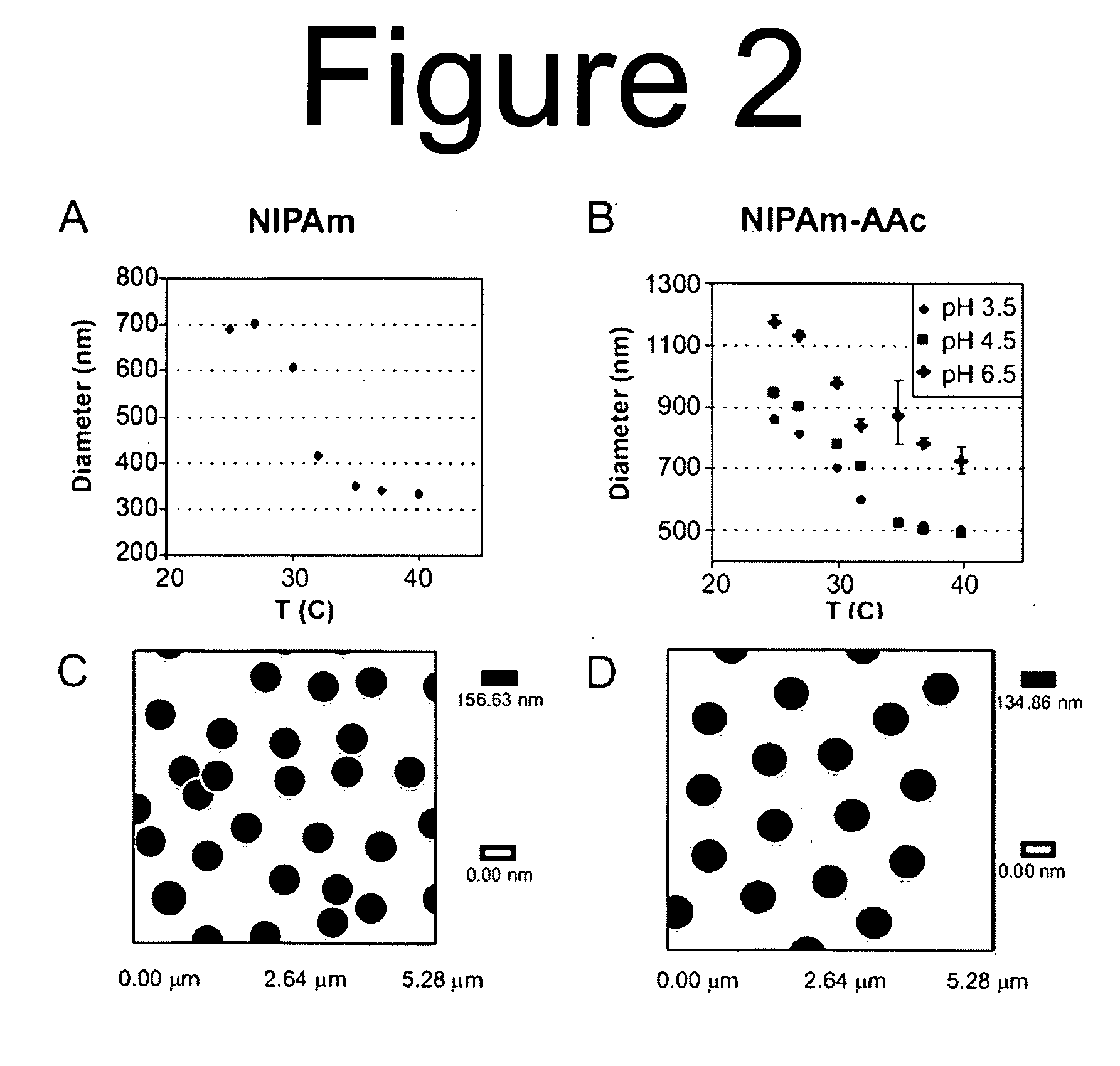Method for Harvesting Nanoparticles and Sequestering Biomarkers
a nanoparticle and biomarker technology, applied in the field of nanoparticles, can solve the problems of ineffective treatment, low molecular weight protein and metabolite detection sensitivity and resolution, and conventional methods such as two-dimensional gel electrophoresis, and achieve the effect of significantly reducing the yield of candidate biomarkers, reducing the yield of low molecular weight proteins and metabolites, and reducing the yield of high molecular weight proteins
- Summary
- Abstract
- Description
- Claims
- Application Information
AI Technical Summary
Benefits of technology
Problems solved by technology
Method used
Image
Examples
example 1
Capture Particles Incorporating N-Isopropylacrylamide (NIPAm)
[0149]Capture particles incorporating N-Isopropylacrylamide (NIPAm) and N,N-methylenebisacrylamide (BIS) were created by surfactant-free precipitation polymerization. BIS was used as the crosslinker, and the BIS:NIPAm monomer ratio determined the resultant network density and thus the average pore size. Further, a preparation of particles containing acrylic acid (AAc) was fabricated in order to incorporate a charge-based affinity bait into the particles. N-Isopropylacrylamide (NIPAm), N,N′-methylenebisacrylamide (BIS), ammonium persulfate (APS), acrylic acid (AAc) were purchased from Sigma-Aldrich of St. Louis, Mo. Water for reactions, washing and loading will be purified with a Millipore Milli-Q water purification system to a resistance of 18 MΩ and passed through a 0.2 μm filter.
[0150]The total monomer concentration (NIPAm and BIS) was 0.3 M. Particles were made using varying amounts of crosslinker during polymerization,...
example 2
Electro-Transport of the Particles
[0153]Serum incubated particles with 2% crosslinker were loaded in a sample tube of centrilutor micro-electroeluter (Millipore) where a 5 mm long 30% acrylamide / bis gel slice was previously polymerized. When an electric field was created, particles migrated towards the positive electrode through the gel slice without losing their protein content.
example 3
Hydrogel Particles
[0154]The ability of hydrogel particles to perform directly, in one step and in solution, the partition, affinity separation, concentration, and stabilization of low molecular weight proteins in serum was analyzed as a new rapid method for blood derived biomarker isolation and analysis. Hydrogels, by definition, are three-dimensional cross-linked polymeric networks that can imbibe large amounts of water (Pelton, R. Adv Colloid Interface Sci 2000, 85, (1), 1-33). They are usually formed through monomer polymerization in the presence of a cross-linking agent, which is typically a monomer with at least two polymerizable functional moieties. Gels can be categorized as non-responsive (simple polymeric networks dramatically swell upon exposure to water) or responsive gels (have added functionality and display changes in solvation in response to certain stimuli such as temperature (Li and Tanaka, The Journal of Chemical Physics 1990, 92, (2), 1365-1371) pH, (Jones and Lyo...
PUM
| Property | Measurement | Unit |
|---|---|---|
| concentration | aaaaa | aaaaa |
| half life | aaaaa | aaaaa |
| pH | aaaaa | aaaaa |
Abstract
Description
Claims
Application Information
 Login to View More
Login to View More - R&D
- Intellectual Property
- Life Sciences
- Materials
- Tech Scout
- Unparalleled Data Quality
- Higher Quality Content
- 60% Fewer Hallucinations
Browse by: Latest US Patents, China's latest patents, Technical Efficacy Thesaurus, Application Domain, Technology Topic, Popular Technical Reports.
© 2025 PatSnap. All rights reserved.Legal|Privacy policy|Modern Slavery Act Transparency Statement|Sitemap|About US| Contact US: help@patsnap.com



